Analyzing Business Contexts and Management at Tesco PLC
VerifiedAdded on 2023/06/10
|13
|3509
|441
Report
AI Summary
This report provides an analysis of Tesco PLC, a major retail giant, focusing on its business contexts and management strategies. It evaluates the industry in which Tesco operates, including an analysis of the external environment using tools like the business cycle model and an internal competence analysis leveraging the McKinsey 7s Model. The report also examines the impact of organizational culture and change, employing frameworks such as Kurt Lewin's change management model and Handy's cultural model. Furthermore, it identifies and maps Tesco's internal and external stakeholders, assessing their influence on management decisions. The analysis concludes with an industry report summarizing key findings and implications for Tesco's strategic positioning in a competitive market.
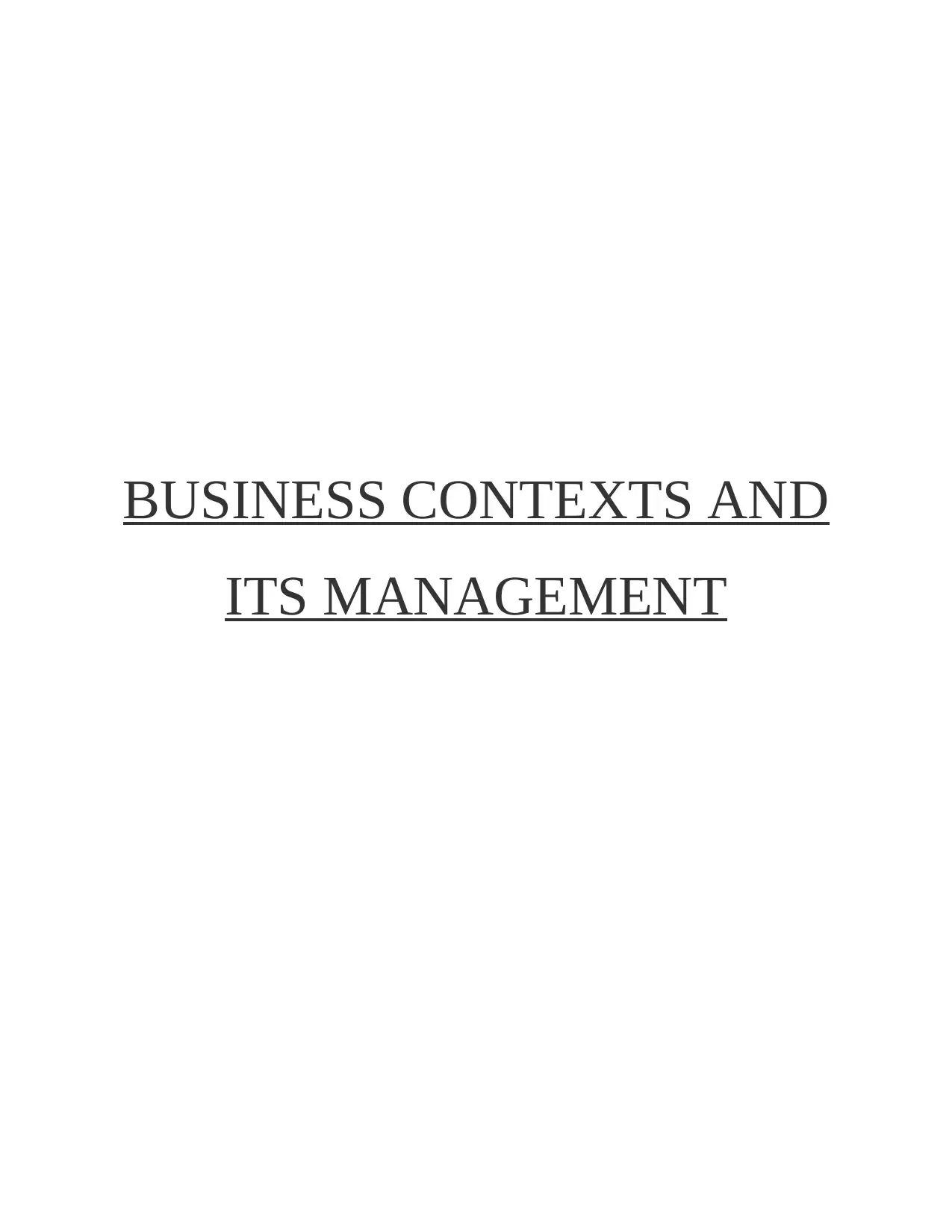
BUSINESS CONTEXTS AND
ITS MANAGEMENT
ITS MANAGEMENT
Paraphrase This Document
Need a fresh take? Get an instant paraphrase of this document with our AI Paraphraser
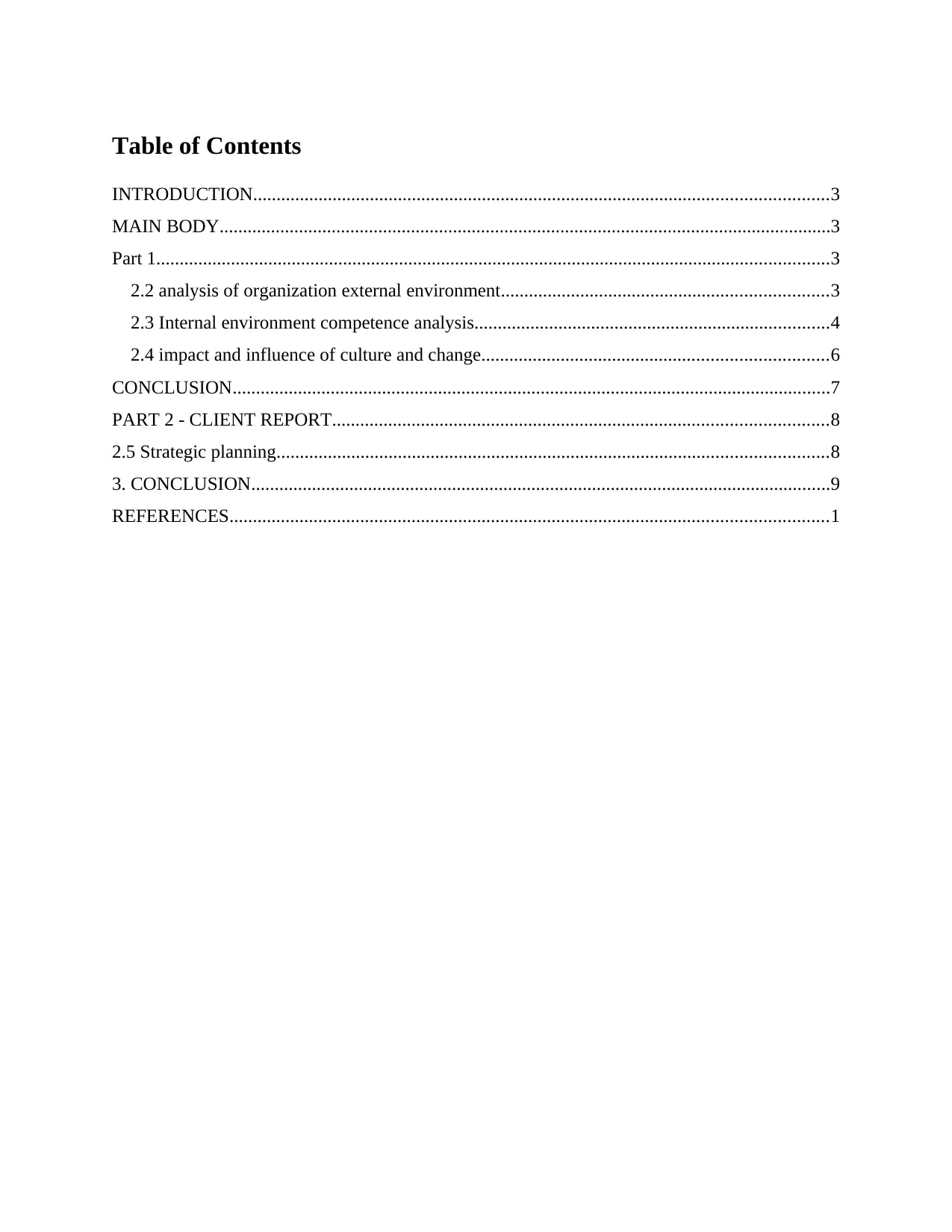
Table of Contents
INTRODUCTION...........................................................................................................................3
MAIN BODY...................................................................................................................................3
Part 1................................................................................................................................................3
2.2 analysis of organization external environment......................................................................3
2.3 Internal environment competence analysis............................................................................4
2.4 impact and influence of culture and change..........................................................................6
CONCLUSION................................................................................................................................7
PART 2 - CLIENT REPORT..........................................................................................................8
2.5 Strategic planning......................................................................................................................8
3. CONCLUSION............................................................................................................................9
REFERENCES................................................................................................................................1
INTRODUCTION...........................................................................................................................3
MAIN BODY...................................................................................................................................3
Part 1................................................................................................................................................3
2.2 analysis of organization external environment......................................................................3
2.3 Internal environment competence analysis............................................................................4
2.4 impact and influence of culture and change..........................................................................6
CONCLUSION................................................................................................................................7
PART 2 - CLIENT REPORT..........................................................................................................8
2.5 Strategic planning......................................................................................................................8
3. CONCLUSION............................................................................................................................9
REFERENCES................................................................................................................................1
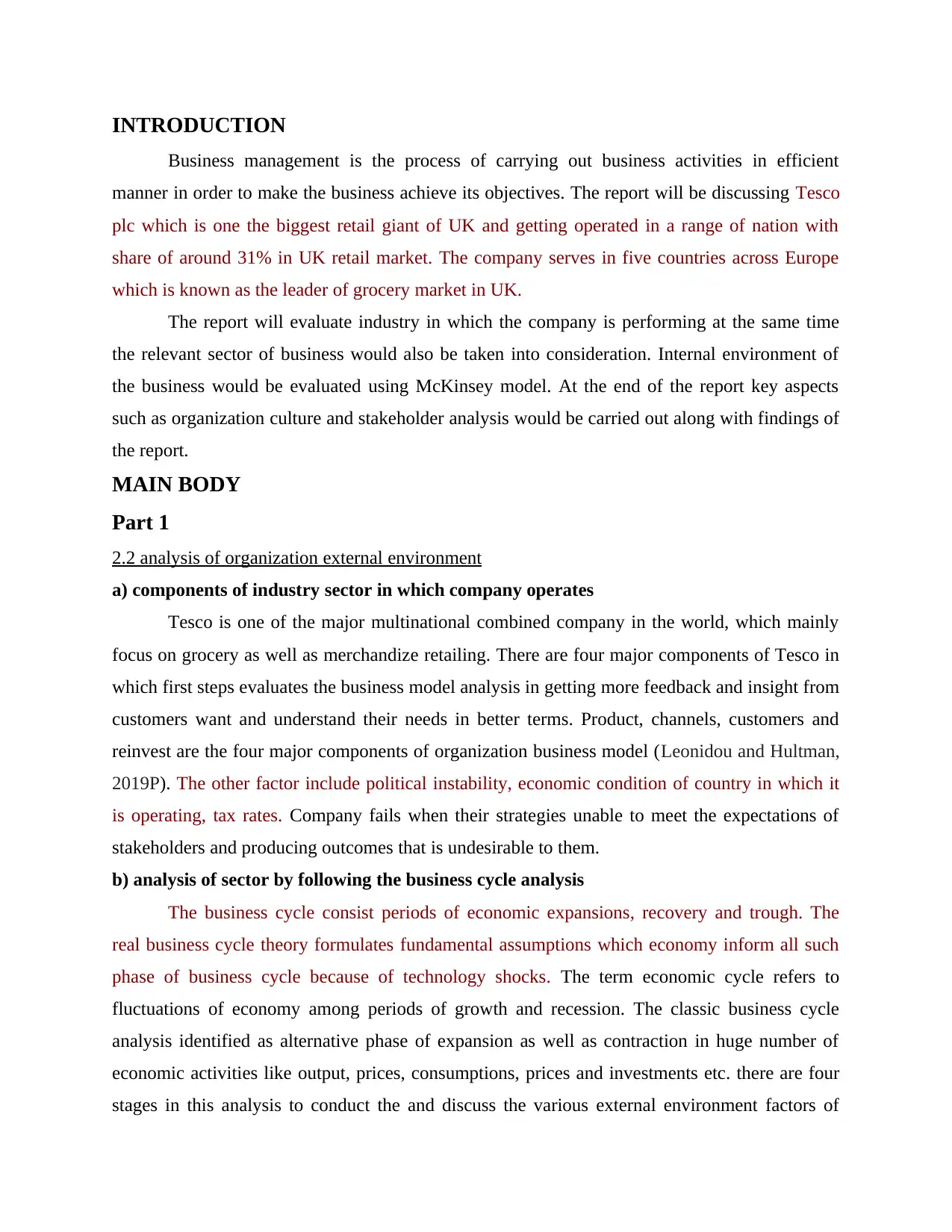
INTRODUCTION
Business management is the process of carrying out business activities in efficient
manner in order to make the business achieve its objectives. The report will be discussing Tesco
plc which is one the biggest retail giant of UK and getting operated in a range of nation with
share of around 31% in UK retail market. The company serves in five countries across Europe
which is known as the leader of grocery market in UK.
The report will evaluate industry in which the company is performing at the same time
the relevant sector of business would also be taken into consideration. Internal environment of
the business would be evaluated using McKinsey model. At the end of the report key aspects
such as organization culture and stakeholder analysis would be carried out along with findings of
the report.
MAIN BODY
Part 1
2.2 analysis of organization external environment
a) components of industry sector in which company operates
Tesco is one of the major multinational combined company in the world, which mainly
focus on grocery as well as merchandize retailing. There are four major components of Tesco in
which first steps evaluates the business model analysis in getting more feedback and insight from
customers want and understand their needs in better terms. Product, channels, customers and
reinvest are the four major components of organization business model (Leonidou and Hultman,
2019P). The other factor include political instability, economic condition of country in which it
is operating, tax rates. Company fails when their strategies unable to meet the expectations of
stakeholders and producing outcomes that is undesirable to them.
b) analysis of sector by following the business cycle analysis
The business cycle consist periods of economic expansions, recovery and trough. The
real business cycle theory formulates fundamental assumptions which economy inform all such
phase of business cycle because of technology shocks. The term economic cycle refers to
fluctuations of economy among periods of growth and recession. The classic business cycle
analysis identified as alternative phase of expansion as well as contraction in huge number of
economic activities like output, prices, consumptions, prices and investments etc. there are four
stages in this analysis to conduct the and discuss the various external environment factors of
Business management is the process of carrying out business activities in efficient
manner in order to make the business achieve its objectives. The report will be discussing Tesco
plc which is one the biggest retail giant of UK and getting operated in a range of nation with
share of around 31% in UK retail market. The company serves in five countries across Europe
which is known as the leader of grocery market in UK.
The report will evaluate industry in which the company is performing at the same time
the relevant sector of business would also be taken into consideration. Internal environment of
the business would be evaluated using McKinsey model. At the end of the report key aspects
such as organization culture and stakeholder analysis would be carried out along with findings of
the report.
MAIN BODY
Part 1
2.2 analysis of organization external environment
a) components of industry sector in which company operates
Tesco is one of the major multinational combined company in the world, which mainly
focus on grocery as well as merchandize retailing. There are four major components of Tesco in
which first steps evaluates the business model analysis in getting more feedback and insight from
customers want and understand their needs in better terms. Product, channels, customers and
reinvest are the four major components of organization business model (Leonidou and Hultman,
2019P). The other factor include political instability, economic condition of country in which it
is operating, tax rates. Company fails when their strategies unable to meet the expectations of
stakeholders and producing outcomes that is undesirable to them.
b) analysis of sector by following the business cycle analysis
The business cycle consist periods of economic expansions, recovery and trough. The
real business cycle theory formulates fundamental assumptions which economy inform all such
phase of business cycle because of technology shocks. The term economic cycle refers to
fluctuations of economy among periods of growth and recession. The classic business cycle
analysis identified as alternative phase of expansion as well as contraction in huge number of
economic activities like output, prices, consumptions, prices and investments etc. there are four
stages in this analysis to conduct the and discuss the various external environment factors of
⊘ This is a preview!⊘
Do you want full access?
Subscribe today to unlock all pages.

Trusted by 1+ million students worldwide
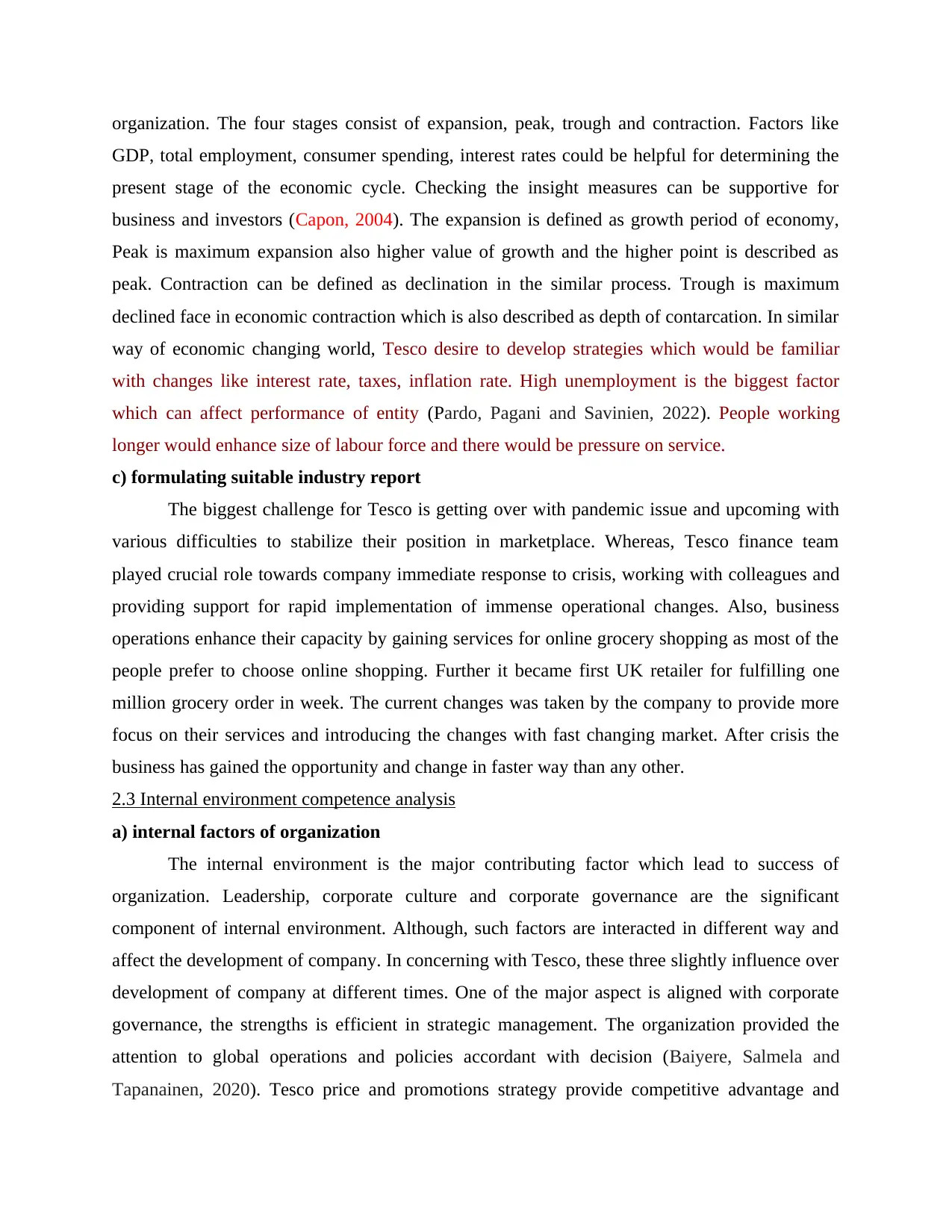
organization. The four stages consist of expansion, peak, trough and contraction. Factors like
GDP, total employment, consumer spending, interest rates could be helpful for determining the
present stage of the economic cycle. Checking the insight measures can be supportive for
business and investors (Capon, 2004). The expansion is defined as growth period of economy,
Peak is maximum expansion also higher value of growth and the higher point is described as
peak. Contraction can be defined as declination in the similar process. Trough is maximum
declined face in economic contraction which is also described as depth of contarcation. In similar
way of economic changing world, Tesco desire to develop strategies which would be familiar
with changes like interest rate, taxes, inflation rate. High unemployment is the biggest factor
which can affect performance of entity (Pardo, Pagani and Savinien, 2022). People working
longer would enhance size of labour force and there would be pressure on service.
c) formulating suitable industry report
The biggest challenge for Tesco is getting over with pandemic issue and upcoming with
various difficulties to stabilize their position in marketplace. Whereas, Tesco finance team
played crucial role towards company immediate response to crisis, working with colleagues and
providing support for rapid implementation of immense operational changes. Also, business
operations enhance their capacity by gaining services for online grocery shopping as most of the
people prefer to choose online shopping. Further it became first UK retailer for fulfilling one
million grocery order in week. The current changes was taken by the company to provide more
focus on their services and introducing the changes with fast changing market. After crisis the
business has gained the opportunity and change in faster way than any other.
2.3 Internal environment competence analysis
a) internal factors of organization
The internal environment is the major contributing factor which lead to success of
organization. Leadership, corporate culture and corporate governance are the significant
component of internal environment. Although, such factors are interacted in different way and
affect the development of company. In concerning with Tesco, these three slightly influence over
development of company at different times. One of the major aspect is aligned with corporate
governance, the strengths is efficient in strategic management. The organization provided the
attention to global operations and policies accordant with decision (Baiyere, Salmela and
Tapanainen, 2020). Tesco price and promotions strategy provide competitive advantage and
GDP, total employment, consumer spending, interest rates could be helpful for determining the
present stage of the economic cycle. Checking the insight measures can be supportive for
business and investors (Capon, 2004). The expansion is defined as growth period of economy,
Peak is maximum expansion also higher value of growth and the higher point is described as
peak. Contraction can be defined as declination in the similar process. Trough is maximum
declined face in economic contraction which is also described as depth of contarcation. In similar
way of economic changing world, Tesco desire to develop strategies which would be familiar
with changes like interest rate, taxes, inflation rate. High unemployment is the biggest factor
which can affect performance of entity (Pardo, Pagani and Savinien, 2022). People working
longer would enhance size of labour force and there would be pressure on service.
c) formulating suitable industry report
The biggest challenge for Tesco is getting over with pandemic issue and upcoming with
various difficulties to stabilize their position in marketplace. Whereas, Tesco finance team
played crucial role towards company immediate response to crisis, working with colleagues and
providing support for rapid implementation of immense operational changes. Also, business
operations enhance their capacity by gaining services for online grocery shopping as most of the
people prefer to choose online shopping. Further it became first UK retailer for fulfilling one
million grocery order in week. The current changes was taken by the company to provide more
focus on their services and introducing the changes with fast changing market. After crisis the
business has gained the opportunity and change in faster way than any other.
2.3 Internal environment competence analysis
a) internal factors of organization
The internal environment is the major contributing factor which lead to success of
organization. Leadership, corporate culture and corporate governance are the significant
component of internal environment. Although, such factors are interacted in different way and
affect the development of company. In concerning with Tesco, these three slightly influence over
development of company at different times. One of the major aspect is aligned with corporate
governance, the strengths is efficient in strategic management. The organization provided the
attention to global operations and policies accordant with decision (Baiyere, Salmela and
Tapanainen, 2020). Tesco price and promotions strategy provide competitive advantage and
Paraphrase This Document
Need a fresh take? Get an instant paraphrase of this document with our AI Paraphraser
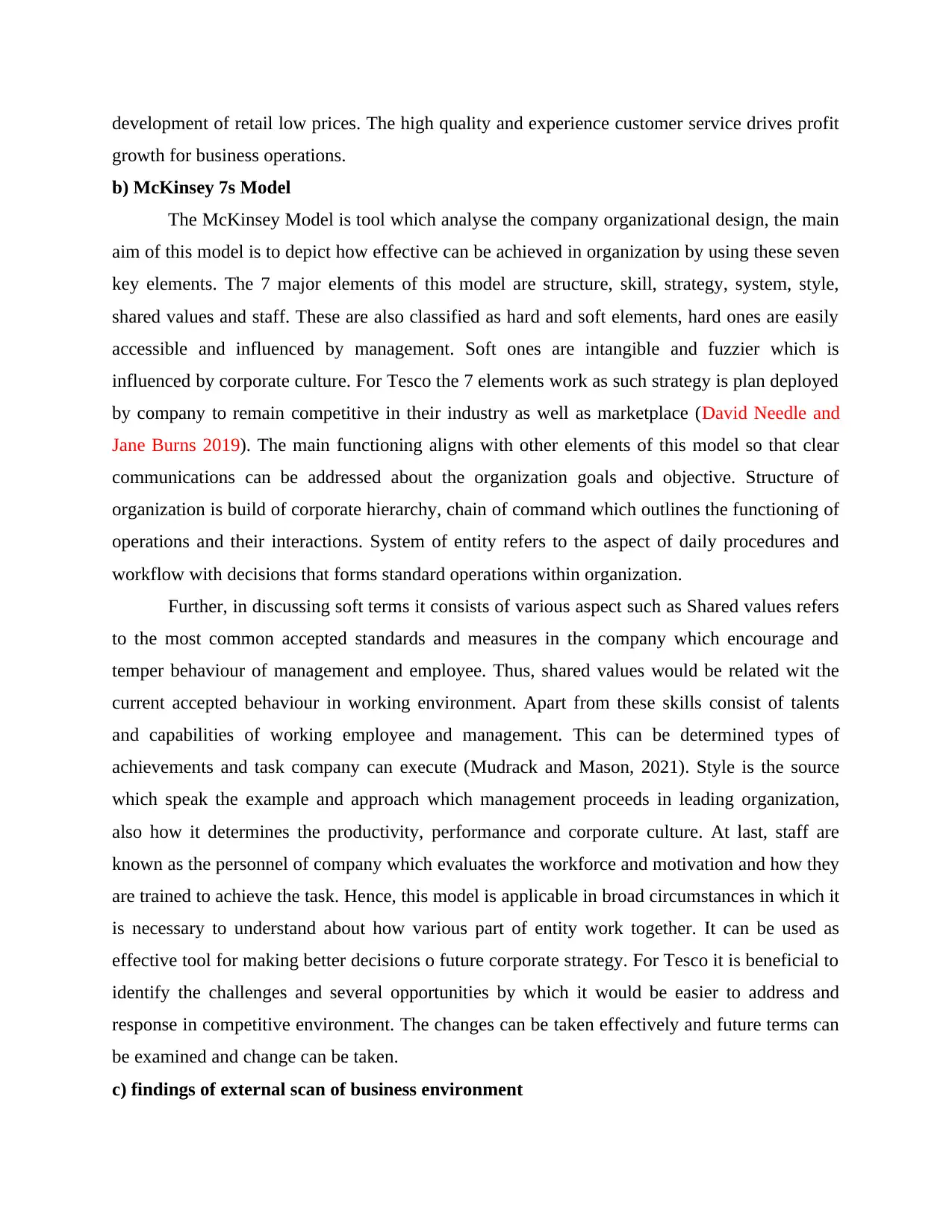
development of retail low prices. The high quality and experience customer service drives profit
growth for business operations.
b) McKinsey 7s Model
The McKinsey Model is tool which analyse the company organizational design, the main
aim of this model is to depict how effective can be achieved in organization by using these seven
key elements. The 7 major elements of this model are structure, skill, strategy, system, style,
shared values and staff. These are also classified as hard and soft elements, hard ones are easily
accessible and influenced by management. Soft ones are intangible and fuzzier which is
influenced by corporate culture. For Tesco the 7 elements work as such strategy is plan deployed
by company to remain competitive in their industry as well as marketplace (David Needle and
Jane Burns 2019). The main functioning aligns with other elements of this model so that clear
communications can be addressed about the organization goals and objective. Structure of
organization is build of corporate hierarchy, chain of command which outlines the functioning of
operations and their interactions. System of entity refers to the aspect of daily procedures and
workflow with decisions that forms standard operations within organization.
Further, in discussing soft terms it consists of various aspect such as Shared values refers
to the most common accepted standards and measures in the company which encourage and
temper behaviour of management and employee. Thus, shared values would be related wit the
current accepted behaviour in working environment. Apart from these skills consist of talents
and capabilities of working employee and management. This can be determined types of
achievements and task company can execute (Mudrack and Mason, 2021). Style is the source
which speak the example and approach which management proceeds in leading organization,
also how it determines the productivity, performance and corporate culture. At last, staff are
known as the personnel of company which evaluates the workforce and motivation and how they
are trained to achieve the task. Hence, this model is applicable in broad circumstances in which it
is necessary to understand about how various part of entity work together. It can be used as
effective tool for making better decisions o future corporate strategy. For Tesco it is beneficial to
identify the challenges and several opportunities by which it would be easier to address and
response in competitive environment. The changes can be taken effectively and future terms can
be examined and change can be taken.
c) findings of external scan of business environment
growth for business operations.
b) McKinsey 7s Model
The McKinsey Model is tool which analyse the company organizational design, the main
aim of this model is to depict how effective can be achieved in organization by using these seven
key elements. The 7 major elements of this model are structure, skill, strategy, system, style,
shared values and staff. These are also classified as hard and soft elements, hard ones are easily
accessible and influenced by management. Soft ones are intangible and fuzzier which is
influenced by corporate culture. For Tesco the 7 elements work as such strategy is plan deployed
by company to remain competitive in their industry as well as marketplace (David Needle and
Jane Burns 2019). The main functioning aligns with other elements of this model so that clear
communications can be addressed about the organization goals and objective. Structure of
organization is build of corporate hierarchy, chain of command which outlines the functioning of
operations and their interactions. System of entity refers to the aspect of daily procedures and
workflow with decisions that forms standard operations within organization.
Further, in discussing soft terms it consists of various aspect such as Shared values refers
to the most common accepted standards and measures in the company which encourage and
temper behaviour of management and employee. Thus, shared values would be related wit the
current accepted behaviour in working environment. Apart from these skills consist of talents
and capabilities of working employee and management. This can be determined types of
achievements and task company can execute (Mudrack and Mason, 2021). Style is the source
which speak the example and approach which management proceeds in leading organization,
also how it determines the productivity, performance and corporate culture. At last, staff are
known as the personnel of company which evaluates the workforce and motivation and how they
are trained to achieve the task. Hence, this model is applicable in broad circumstances in which it
is necessary to understand about how various part of entity work together. It can be used as
effective tool for making better decisions o future corporate strategy. For Tesco it is beneficial to
identify the challenges and several opportunities by which it would be easier to address and
response in competitive environment. The changes can be taken effectively and future terms can
be examined and change can be taken.
c) findings of external scan of business environment
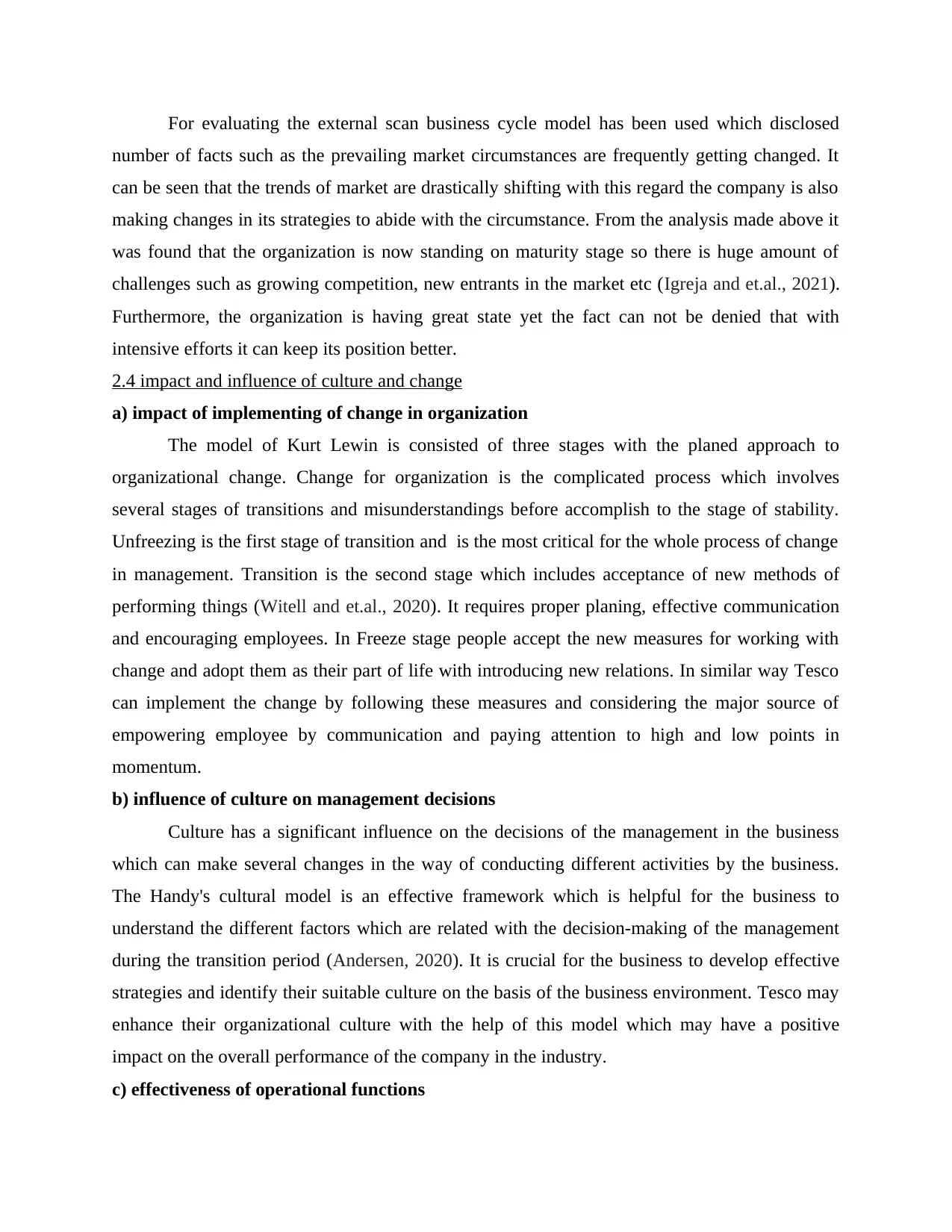
For evaluating the external scan business cycle model has been used which disclosed
number of facts such as the prevailing market circumstances are frequently getting changed. It
can be seen that the trends of market are drastically shifting with this regard the company is also
making changes in its strategies to abide with the circumstance. From the analysis made above it
was found that the organization is now standing on maturity stage so there is huge amount of
challenges such as growing competition, new entrants in the market etc (Igreja and et.al., 2021).
Furthermore, the organization is having great state yet the fact can not be denied that with
intensive efforts it can keep its position better.
2.4 impact and influence of culture and change
a) impact of implementing of change in organization
The model of Kurt Lewin is consisted of three stages with the planed approach to
organizational change. Change for organization is the complicated process which involves
several stages of transitions and misunderstandings before accomplish to the stage of stability.
Unfreezing is the first stage of transition and is the most critical for the whole process of change
in management. Transition is the second stage which includes acceptance of new methods of
performing things (Witell and et.al., 2020). It requires proper planing, effective communication
and encouraging employees. In Freeze stage people accept the new measures for working with
change and adopt them as their part of life with introducing new relations. In similar way Tesco
can implement the change by following these measures and considering the major source of
empowering employee by communication and paying attention to high and low points in
momentum.
b) influence of culture on management decisions
Culture has a significant influence on the decisions of the management in the business
which can make several changes in the way of conducting different activities by the business.
The Handy's cultural model is an effective framework which is helpful for the business to
understand the different factors which are related with the decision-making of the management
during the transition period (Andersen, 2020). It is crucial for the business to develop effective
strategies and identify their suitable culture on the basis of the business environment. Tesco may
enhance their organizational culture with the help of this model which may have a positive
impact on the overall performance of the company in the industry.
c) effectiveness of operational functions
number of facts such as the prevailing market circumstances are frequently getting changed. It
can be seen that the trends of market are drastically shifting with this regard the company is also
making changes in its strategies to abide with the circumstance. From the analysis made above it
was found that the organization is now standing on maturity stage so there is huge amount of
challenges such as growing competition, new entrants in the market etc (Igreja and et.al., 2021).
Furthermore, the organization is having great state yet the fact can not be denied that with
intensive efforts it can keep its position better.
2.4 impact and influence of culture and change
a) impact of implementing of change in organization
The model of Kurt Lewin is consisted of three stages with the planed approach to
organizational change. Change for organization is the complicated process which involves
several stages of transitions and misunderstandings before accomplish to the stage of stability.
Unfreezing is the first stage of transition and is the most critical for the whole process of change
in management. Transition is the second stage which includes acceptance of new methods of
performing things (Witell and et.al., 2020). It requires proper planing, effective communication
and encouraging employees. In Freeze stage people accept the new measures for working with
change and adopt them as their part of life with introducing new relations. In similar way Tesco
can implement the change by following these measures and considering the major source of
empowering employee by communication and paying attention to high and low points in
momentum.
b) influence of culture on management decisions
Culture has a significant influence on the decisions of the management in the business
which can make several changes in the way of conducting different activities by the business.
The Handy's cultural model is an effective framework which is helpful for the business to
understand the different factors which are related with the decision-making of the management
during the transition period (Andersen, 2020). It is crucial for the business to develop effective
strategies and identify their suitable culture on the basis of the business environment. Tesco may
enhance their organizational culture with the help of this model which may have a positive
impact on the overall performance of the company in the industry.
c) effectiveness of operational functions
⊘ This is a preview!⊘
Do you want full access?
Subscribe today to unlock all pages.

Trusted by 1+ million students worldwide
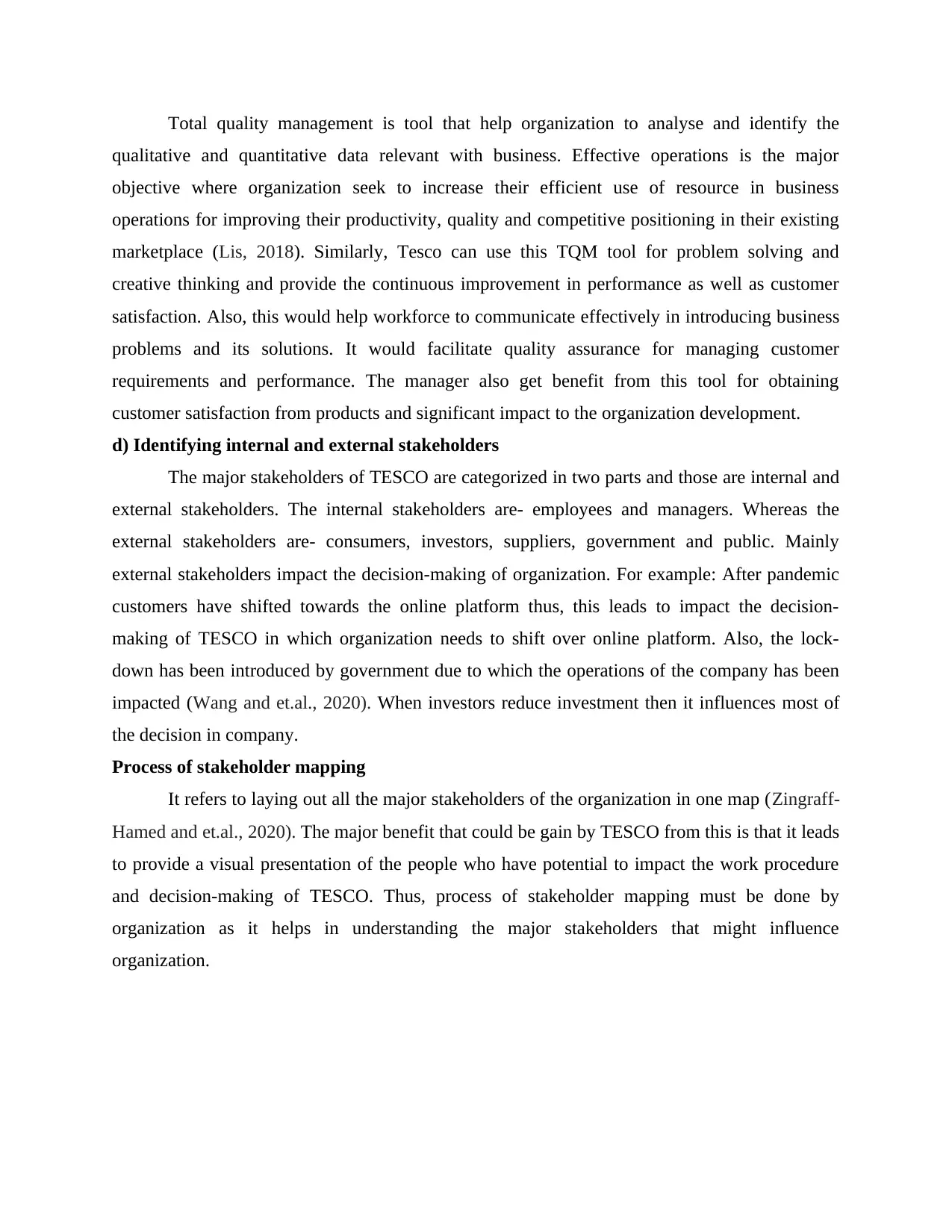
Total quality management is tool that help organization to analyse and identify the
qualitative and quantitative data relevant with business. Effective operations is the major
objective where organization seek to increase their efficient use of resource in business
operations for improving their productivity, quality and competitive positioning in their existing
marketplace (Lis, 2018). Similarly, Tesco can use this TQM tool for problem solving and
creative thinking and provide the continuous improvement in performance as well as customer
satisfaction. Also, this would help workforce to communicate effectively in introducing business
problems and its solutions. It would facilitate quality assurance for managing customer
requirements and performance. The manager also get benefit from this tool for obtaining
customer satisfaction from products and significant impact to the organization development.
d) Identifying internal and external stakeholders
The major stakeholders of TESCO are categorized in two parts and those are internal and
external stakeholders. The internal stakeholders are- employees and managers. Whereas the
external stakeholders are- consumers, investors, suppliers, government and public. Mainly
external stakeholders impact the decision-making of organization. For example: After pandemic
customers have shifted towards the online platform thus, this leads to impact the decision-
making of TESCO in which organization needs to shift over online platform. Also, the lock-
down has been introduced by government due to which the operations of the company has been
impacted (Wang and et.al., 2020). When investors reduce investment then it influences most of
the decision in company.
Process of stakeholder mapping
It refers to laying out all the major stakeholders of the organization in one map (Zingraff-
Hamed and et.al., 2020). The major benefit that could be gain by TESCO from this is that it leads
to provide a visual presentation of the people who have potential to impact the work procedure
and decision-making of TESCO. Thus, process of stakeholder mapping must be done by
organization as it helps in understanding the major stakeholders that might influence
organization.
qualitative and quantitative data relevant with business. Effective operations is the major
objective where organization seek to increase their efficient use of resource in business
operations for improving their productivity, quality and competitive positioning in their existing
marketplace (Lis, 2018). Similarly, Tesco can use this TQM tool for problem solving and
creative thinking and provide the continuous improvement in performance as well as customer
satisfaction. Also, this would help workforce to communicate effectively in introducing business
problems and its solutions. It would facilitate quality assurance for managing customer
requirements and performance. The manager also get benefit from this tool for obtaining
customer satisfaction from products and significant impact to the organization development.
d) Identifying internal and external stakeholders
The major stakeholders of TESCO are categorized in two parts and those are internal and
external stakeholders. The internal stakeholders are- employees and managers. Whereas the
external stakeholders are- consumers, investors, suppliers, government and public. Mainly
external stakeholders impact the decision-making of organization. For example: After pandemic
customers have shifted towards the online platform thus, this leads to impact the decision-
making of TESCO in which organization needs to shift over online platform. Also, the lock-
down has been introduced by government due to which the operations of the company has been
impacted (Wang and et.al., 2020). When investors reduce investment then it influences most of
the decision in company.
Process of stakeholder mapping
It refers to laying out all the major stakeholders of the organization in one map (Zingraff-
Hamed and et.al., 2020). The major benefit that could be gain by TESCO from this is that it leads
to provide a visual presentation of the people who have potential to impact the work procedure
and decision-making of TESCO. Thus, process of stakeholder mapping must be done by
organization as it helps in understanding the major stakeholders that might influence
organization.
Paraphrase This Document
Need a fresh take? Get an instant paraphrase of this document with our AI Paraphraser
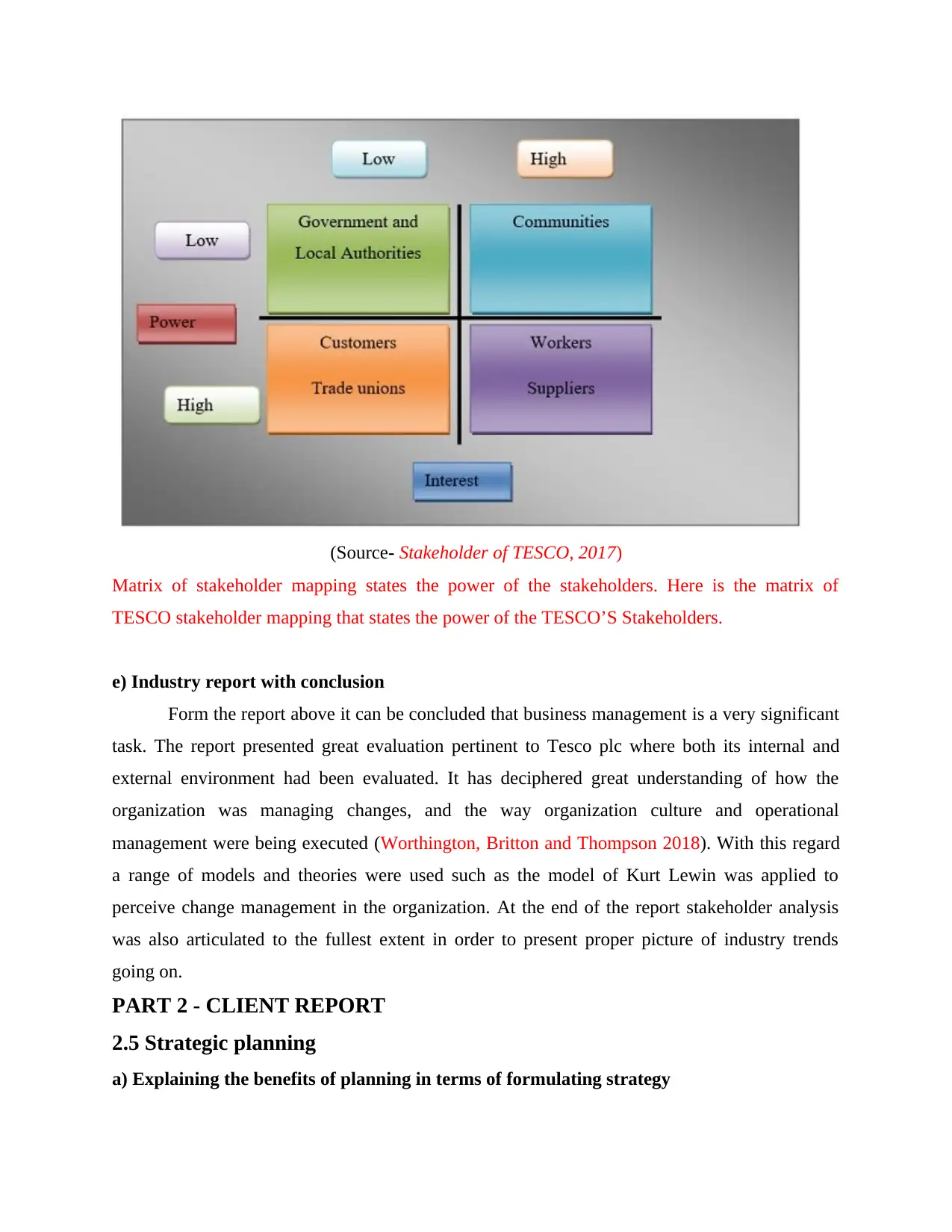
(Source- Stakeholder of TESCO, 2017)
Matrix of stakeholder mapping states the power of the stakeholders. Here is the matrix of
TESCO stakeholder mapping that states the power of the TESCO’S Stakeholders.
e) Industry report with conclusion
Form the report above it can be concluded that business management is a very significant
task. The report presented great evaluation pertinent to Tesco plc where both its internal and
external environment had been evaluated. It has deciphered great understanding of how the
organization was managing changes, and the way organization culture and operational
management were being executed (Worthington, Britton and Thompson 2018). With this regard
a range of models and theories were used such as the model of Kurt Lewin was applied to
perceive change management in the organization. At the end of the report stakeholder analysis
was also articulated to the fullest extent in order to present proper picture of industry trends
going on.
PART 2 - CLIENT REPORT
2.5 Strategic planning
a) Explaining the benefits of planning in terms of formulating strategy
Matrix of stakeholder mapping states the power of the stakeholders. Here is the matrix of
TESCO stakeholder mapping that states the power of the TESCO’S Stakeholders.
e) Industry report with conclusion
Form the report above it can be concluded that business management is a very significant
task. The report presented great evaluation pertinent to Tesco plc where both its internal and
external environment had been evaluated. It has deciphered great understanding of how the
organization was managing changes, and the way organization culture and operational
management were being executed (Worthington, Britton and Thompson 2018). With this regard
a range of models and theories were used such as the model of Kurt Lewin was applied to
perceive change management in the organization. At the end of the report stakeholder analysis
was also articulated to the fullest extent in order to present proper picture of industry trends
going on.
PART 2 - CLIENT REPORT
2.5 Strategic planning
a) Explaining the benefits of planning in terms of formulating strategy
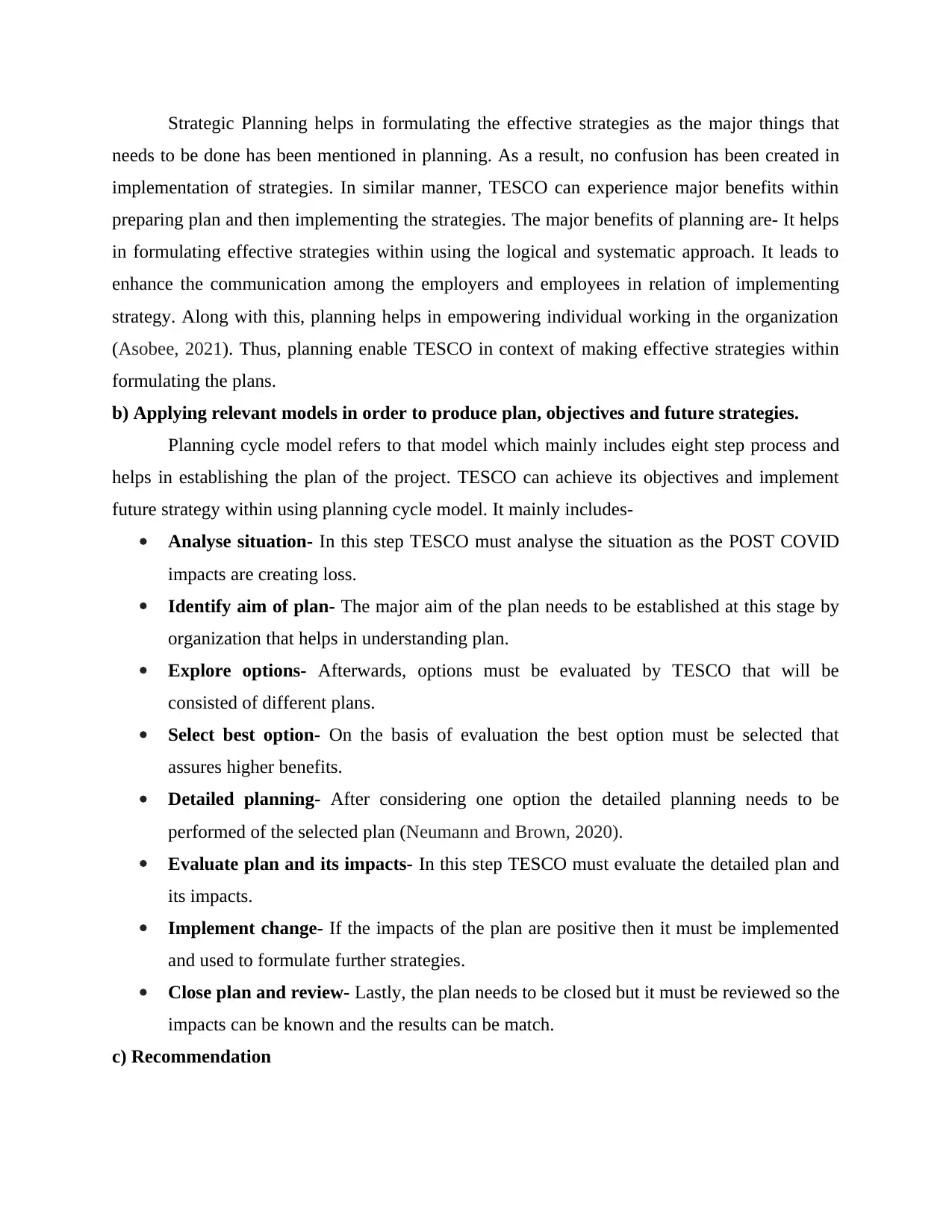
Strategic Planning helps in formulating the effective strategies as the major things that
needs to be done has been mentioned in planning. As a result, no confusion has been created in
implementation of strategies. In similar manner, TESCO can experience major benefits within
preparing plan and then implementing the strategies. The major benefits of planning are- It helps
in formulating effective strategies within using the logical and systematic approach. It leads to
enhance the communication among the employers and employees in relation of implementing
strategy. Along with this, planning helps in empowering individual working in the organization
(Asobee, 2021). Thus, planning enable TESCO in context of making effective strategies within
formulating the plans.
b) Applying relevant models in order to produce plan, objectives and future strategies.
Planning cycle model refers to that model which mainly includes eight step process and
helps in establishing the plan of the project. TESCO can achieve its objectives and implement
future strategy within using planning cycle model. It mainly includes-
Analyse situation- In this step TESCO must analyse the situation as the POST COVID
impacts are creating loss.
Identify aim of plan- The major aim of the plan needs to be established at this stage by
organization that helps in understanding plan.
Explore options- Afterwards, options must be evaluated by TESCO that will be
consisted of different plans.
Select best option- On the basis of evaluation the best option must be selected that
assures higher benefits.
Detailed planning- After considering one option the detailed planning needs to be
performed of the selected plan (Neumann and Brown, 2020).
Evaluate plan and its impacts- In this step TESCO must evaluate the detailed plan and
its impacts.
Implement change- If the impacts of the plan are positive then it must be implemented
and used to formulate further strategies.
Close plan and review- Lastly, the plan needs to be closed but it must be reviewed so the
impacts can be known and the results can be match.
c) Recommendation
needs to be done has been mentioned in planning. As a result, no confusion has been created in
implementation of strategies. In similar manner, TESCO can experience major benefits within
preparing plan and then implementing the strategies. The major benefits of planning are- It helps
in formulating effective strategies within using the logical and systematic approach. It leads to
enhance the communication among the employers and employees in relation of implementing
strategy. Along with this, planning helps in empowering individual working in the organization
(Asobee, 2021). Thus, planning enable TESCO in context of making effective strategies within
formulating the plans.
b) Applying relevant models in order to produce plan, objectives and future strategies.
Planning cycle model refers to that model which mainly includes eight step process and
helps in establishing the plan of the project. TESCO can achieve its objectives and implement
future strategy within using planning cycle model. It mainly includes-
Analyse situation- In this step TESCO must analyse the situation as the POST COVID
impacts are creating loss.
Identify aim of plan- The major aim of the plan needs to be established at this stage by
organization that helps in understanding plan.
Explore options- Afterwards, options must be evaluated by TESCO that will be
consisted of different plans.
Select best option- On the basis of evaluation the best option must be selected that
assures higher benefits.
Detailed planning- After considering one option the detailed planning needs to be
performed of the selected plan (Neumann and Brown, 2020).
Evaluate plan and its impacts- In this step TESCO must evaluate the detailed plan and
its impacts.
Implement change- If the impacts of the plan are positive then it must be implemented
and used to formulate further strategies.
Close plan and review- Lastly, the plan needs to be closed but it must be reviewed so the
impacts can be known and the results can be match.
c) Recommendation
⊘ This is a preview!⊘
Do you want full access?
Subscribe today to unlock all pages.

Trusted by 1+ million students worldwide
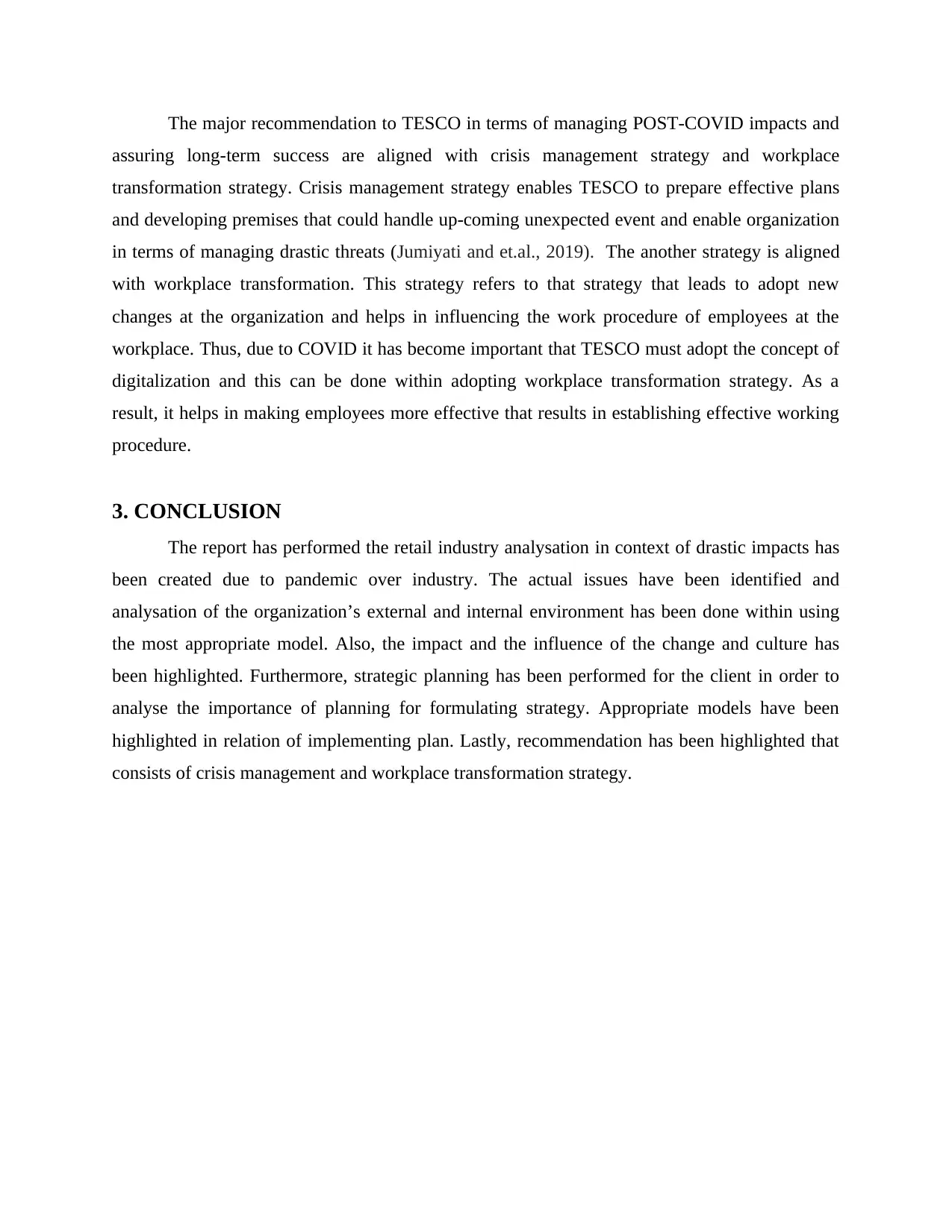
The major recommendation to TESCO in terms of managing POST-COVID impacts and
assuring long-term success are aligned with crisis management strategy and workplace
transformation strategy. Crisis management strategy enables TESCO to prepare effective plans
and developing premises that could handle up-coming unexpected event and enable organization
in terms of managing drastic threats (Jumiyati and et.al., 2019). The another strategy is aligned
with workplace transformation. This strategy refers to that strategy that leads to adopt new
changes at the organization and helps in influencing the work procedure of employees at the
workplace. Thus, due to COVID it has become important that TESCO must adopt the concept of
digitalization and this can be done within adopting workplace transformation strategy. As a
result, it helps in making employees more effective that results in establishing effective working
procedure.
3. CONCLUSION
The report has performed the retail industry analysation in context of drastic impacts has
been created due to pandemic over industry. The actual issues have been identified and
analysation of the organization’s external and internal environment has been done within using
the most appropriate model. Also, the impact and the influence of the change and culture has
been highlighted. Furthermore, strategic planning has been performed for the client in order to
analyse the importance of planning for formulating strategy. Appropriate models have been
highlighted in relation of implementing plan. Lastly, recommendation has been highlighted that
consists of crisis management and workplace transformation strategy.
assuring long-term success are aligned with crisis management strategy and workplace
transformation strategy. Crisis management strategy enables TESCO to prepare effective plans
and developing premises that could handle up-coming unexpected event and enable organization
in terms of managing drastic threats (Jumiyati and et.al., 2019). The another strategy is aligned
with workplace transformation. This strategy refers to that strategy that leads to adopt new
changes at the organization and helps in influencing the work procedure of employees at the
workplace. Thus, due to COVID it has become important that TESCO must adopt the concept of
digitalization and this can be done within adopting workplace transformation strategy. As a
result, it helps in making employees more effective that results in establishing effective working
procedure.
3. CONCLUSION
The report has performed the retail industry analysation in context of drastic impacts has
been created due to pandemic over industry. The actual issues have been identified and
analysation of the organization’s external and internal environment has been done within using
the most appropriate model. Also, the impact and the influence of the change and culture has
been highlighted. Furthermore, strategic planning has been performed for the client in order to
analyse the importance of planning for formulating strategy. Appropriate models have been
highlighted in relation of implementing plan. Lastly, recommendation has been highlighted that
consists of crisis management and workplace transformation strategy.
Paraphrase This Document
Need a fresh take? Get an instant paraphrase of this document with our AI Paraphraser
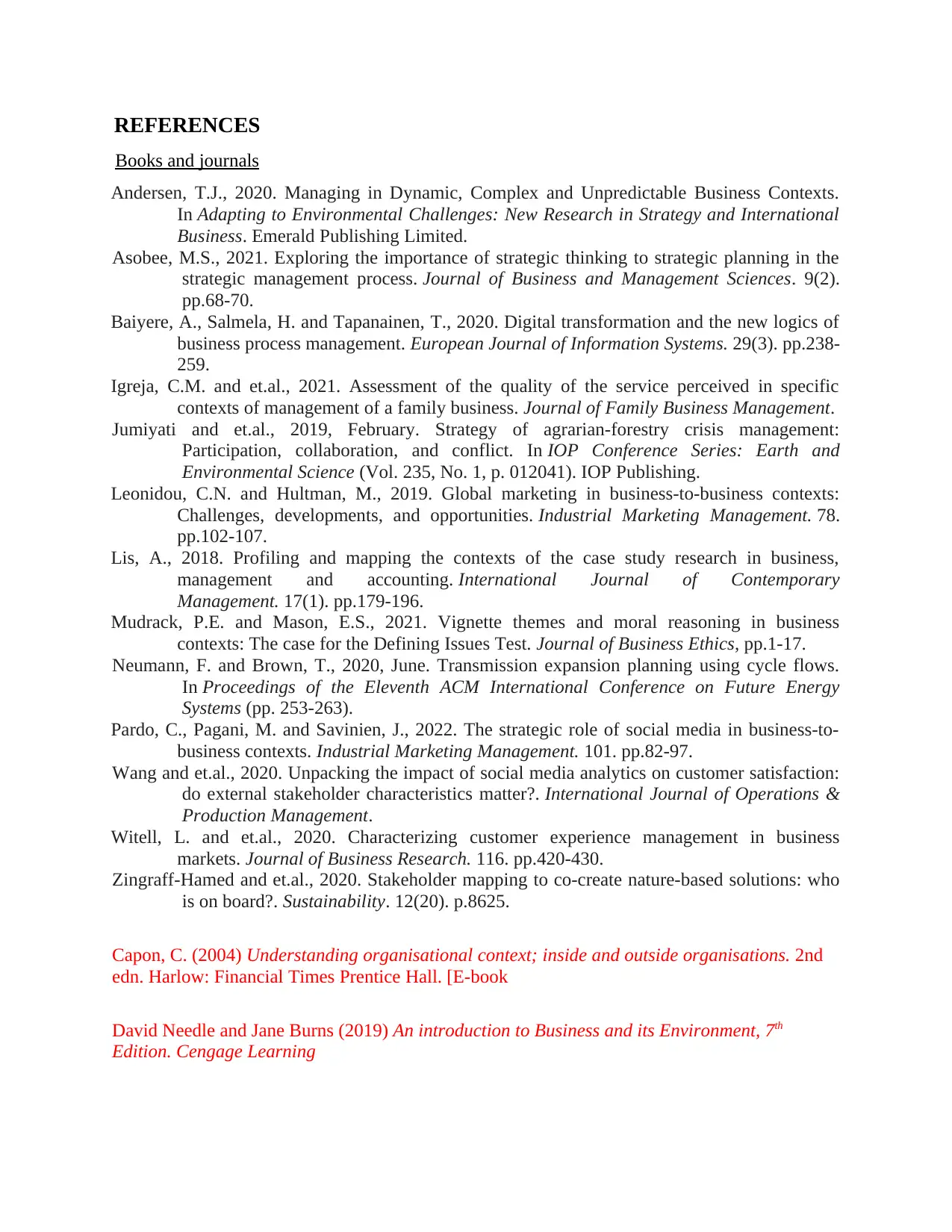
REFERENCES
Books and journals
Andersen, T.J., 2020. Managing in Dynamic, Complex and Unpredictable Business Contexts.
In Adapting to Environmental Challenges: New Research in Strategy and International
Business. Emerald Publishing Limited.
Asobee, M.S., 2021. Exploring the importance of strategic thinking to strategic planning in the
strategic management process. Journal of Business and Management Sciences. 9(2).
pp.68-70.
Baiyere, A., Salmela, H. and Tapanainen, T., 2020. Digital transformation and the new logics of
business process management. European Journal of Information Systems. 29(3). pp.238-
259.
Igreja, C.M. and et.al., 2021. Assessment of the quality of the service perceived in specific
contexts of management of a family business. Journal of Family Business Management.
Jumiyati and et.al., 2019, February. Strategy of agrarian-forestry crisis management:
Participation, collaboration, and conflict. In IOP Conference Series: Earth and
Environmental Science (Vol. 235, No. 1, p. 012041). IOP Publishing.
Leonidou, C.N. and Hultman, M., 2019. Global marketing in business-to-business contexts:
Challenges, developments, and opportunities. Industrial Marketing Management. 78.
pp.102-107.
Lis, A., 2018. Profiling and mapping the contexts of the case study research in business,
management and accounting. International Journal of Contemporary
Management. 17(1). pp.179-196.
Mudrack, P.E. and Mason, E.S., 2021. Vignette themes and moral reasoning in business
contexts: The case for the Defining Issues Test. Journal of Business Ethics, pp.1-17.
Neumann, F. and Brown, T., 2020, June. Transmission expansion planning using cycle flows.
In Proceedings of the Eleventh ACM International Conference on Future Energy
Systems (pp. 253-263).
Pardo, C., Pagani, M. and Savinien, J., 2022. The strategic role of social media in business-to-
business contexts. Industrial Marketing Management. 101. pp.82-97.
Wang and et.al., 2020. Unpacking the impact of social media analytics on customer satisfaction:
do external stakeholder characteristics matter?. International Journal of Operations &
Production Management.
Witell, L. and et.al., 2020. Characterizing customer experience management in business
markets. Journal of Business Research. 116. pp.420-430.
Zingraff-Hamed and et.al., 2020. Stakeholder mapping to co-create nature-based solutions: who
is on board?. Sustainability. 12(20). p.8625.
Capon, C. (2004) Understanding organisational context; inside and outside organisations. 2nd
edn. Harlow: Financial Times Prentice Hall. [E-book
David Needle and Jane Burns (2019) An introduction to Business and its Environment, 7th
Edition. Cengage Learning
Books and journals
Andersen, T.J., 2020. Managing in Dynamic, Complex and Unpredictable Business Contexts.
In Adapting to Environmental Challenges: New Research in Strategy and International
Business. Emerald Publishing Limited.
Asobee, M.S., 2021. Exploring the importance of strategic thinking to strategic planning in the
strategic management process. Journal of Business and Management Sciences. 9(2).
pp.68-70.
Baiyere, A., Salmela, H. and Tapanainen, T., 2020. Digital transformation and the new logics of
business process management. European Journal of Information Systems. 29(3). pp.238-
259.
Igreja, C.M. and et.al., 2021. Assessment of the quality of the service perceived in specific
contexts of management of a family business. Journal of Family Business Management.
Jumiyati and et.al., 2019, February. Strategy of agrarian-forestry crisis management:
Participation, collaboration, and conflict. In IOP Conference Series: Earth and
Environmental Science (Vol. 235, No. 1, p. 012041). IOP Publishing.
Leonidou, C.N. and Hultman, M., 2019. Global marketing in business-to-business contexts:
Challenges, developments, and opportunities. Industrial Marketing Management. 78.
pp.102-107.
Lis, A., 2018. Profiling and mapping the contexts of the case study research in business,
management and accounting. International Journal of Contemporary
Management. 17(1). pp.179-196.
Mudrack, P.E. and Mason, E.S., 2021. Vignette themes and moral reasoning in business
contexts: The case for the Defining Issues Test. Journal of Business Ethics, pp.1-17.
Neumann, F. and Brown, T., 2020, June. Transmission expansion planning using cycle flows.
In Proceedings of the Eleventh ACM International Conference on Future Energy
Systems (pp. 253-263).
Pardo, C., Pagani, M. and Savinien, J., 2022. The strategic role of social media in business-to-
business contexts. Industrial Marketing Management. 101. pp.82-97.
Wang and et.al., 2020. Unpacking the impact of social media analytics on customer satisfaction:
do external stakeholder characteristics matter?. International Journal of Operations &
Production Management.
Witell, L. and et.al., 2020. Characterizing customer experience management in business
markets. Journal of Business Research. 116. pp.420-430.
Zingraff-Hamed and et.al., 2020. Stakeholder mapping to co-create nature-based solutions: who
is on board?. Sustainability. 12(20). p.8625.
Capon, C. (2004) Understanding organisational context; inside and outside organisations. 2nd
edn. Harlow: Financial Times Prentice Hall. [E-book
David Needle and Jane Burns (2019) An introduction to Business and its Environment, 7th
Edition. Cengage Learning
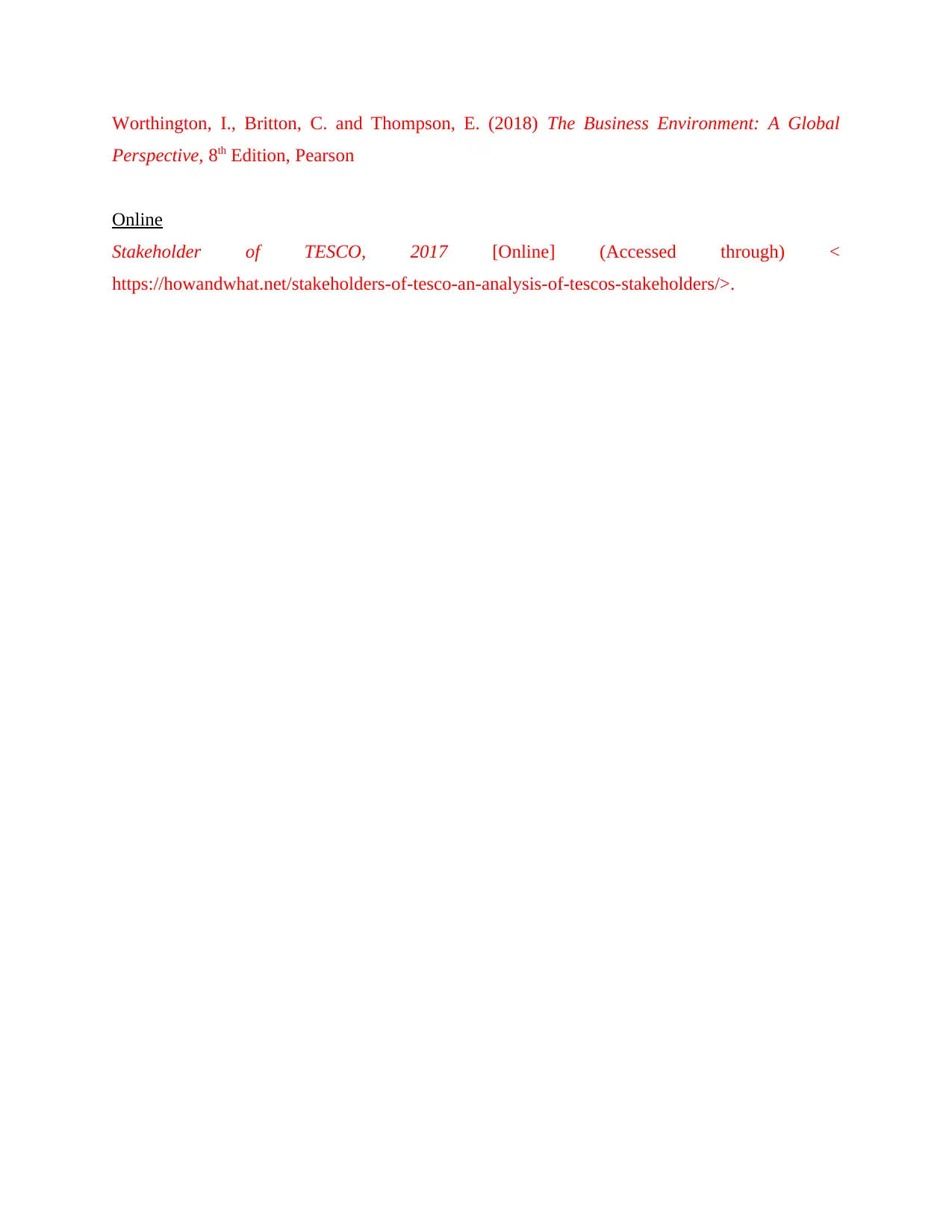
Worthington, I., Britton, C. and Thompson, E. (2018) The Business Environment: A Global
Perspective, 8th Edition, Pearson
Online
Stakeholder of TESCO, 2017 [Online] (Accessed through) <
https://howandwhat.net/stakeholders-of-tesco-an-analysis-of-tescos-stakeholders/>.
Perspective, 8th Edition, Pearson
Online
Stakeholder of TESCO, 2017 [Online] (Accessed through) <
https://howandwhat.net/stakeholders-of-tesco-an-analysis-of-tescos-stakeholders/>.
⊘ This is a preview!⊘
Do you want full access?
Subscribe today to unlock all pages.

Trusted by 1+ million students worldwide
1 out of 13
Related Documents
Your All-in-One AI-Powered Toolkit for Academic Success.
+13062052269
info@desklib.com
Available 24*7 on WhatsApp / Email
![[object Object]](/_next/static/media/star-bottom.7253800d.svg)
Unlock your academic potential
Copyright © 2020–2025 A2Z Services. All Rights Reserved. Developed and managed by ZUCOL.


